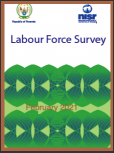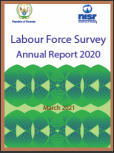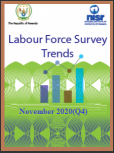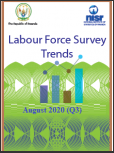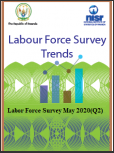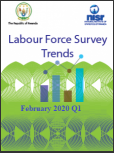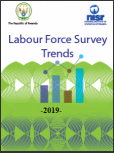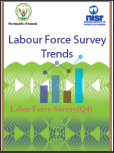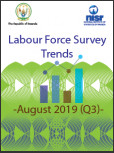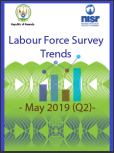Labour Force Survey Trends-February 2021(Q1)
The Labour Force Survey (LFS) programme collect data on employment and labour underutilization characteristics of the population on a continuous basis, providing quarterly estimates of the main labour force aggregates with sufficient precision at the National level since 2016.
Labour Force Survey Annual Report 2020
The Rwanda Labour Force survey programme begun in 2016 with an annual sample spread into two rounds to provide bi-annual estimates of main indicators at the National level. From February 2019, the annual sample was spread into four rounds to provide estimates of main labour market indicators on quarterly basis at the National level. This specific report pull together different rounds of the labour force survey conducted within a specific year namely February, May, August and November.
Labour Force Survey Trends-November 2020(Q4)
The Labour Force Survey (LFS) programme collect data on employment and labour underutilization characteristics of the population on a continuous basis, providing quarterly estimates of the main labour force aggregates with sufficient precision at the National level since 2016.
Labour Force Survey Trends-August 2020(Q3)
The Labour Force Survey (LFS) programme collect data on employment and labour underutilization characteristics of the population on a continuous basis, providing quarterly estimates of the main labour force aggregates with sufficient precision at the district level.
Labour Force Survey Trends-May 2020(Q2)
The ultimate goal of Labour Force Survey (LFS) programme is to collect data on employment and labour underutilization characteristics of the population on a continuous basis, providing quarterly estimates of the main labour force aggregates with sufficient precision at the district level.
Labour Force Survey Trends-February 2020(Q1)
In February 2020(Q1), the working age population (16 years and above) was around 7.4 million and the population in the labour force constituted the majority of working age population. The proportion of population who were in the labour force increased from 52.5 percent in February 2019 to 55.6 percent in February 2020. The proportion of the working age population outside the labour force slightly decreased in the first quarter of 2020 as compared to different quarters of the LFS in 2019.
Labour Force Survey Annual Report 2019
The Rwanda Labour Force survey programme begun in 2016 with an annual sample spread into two rounds to provide bi-annual estimates of main indicators at the National level. From February 2019, the annual sample was spread into four rounds to provide estimates of main labour market indicators on quarterly basis at the National level.
Labour Force Survey Trends-November 2019(Q4)
The sample design of labour force survey presents an advantage of estimating trend of labour market indicators with a higher precision due to its rotational design. In this report, the survey results are compared for February 2019 (Q1), May 2019 (Q2), August 2019 (Q3) and November (Q4). The current report presents in some cases data points including results of the labour force surveys in the previous year.
Labour Force Survey Trends-August 2019(Q3)
The sample design of labour force survey presents an advantage of estimating trend of labour market indicators with a higher precision due to its rotational design. In this report, the survey results are compared for February 2019 (Q1), May 2019 (Q2) and August 2019 (Q3). However, tables are presented in most cases with more data points including results of the labour force surveys in the previous year.
Labour Force Survey Trends-May 2019(Q2)
The focus of the present report has the objective of providing data on the structure and trends of labour force, employment and unemployment as well as other related labour market statistics for the implementation and evaluation of economic and social policies related to employment creation, income generation, skills development, and related decent work policies at the national by selected demographic and socioeconomic characteristics such as sex, age group, educational attainment, occupation and industry.

